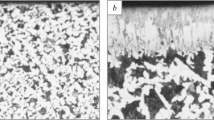Abstract
Boron increases the hardenability of hypoeutectoid steels by decreasing the nucleation rate of ferrite and bainite. It is postulated that concentrations of lattice imperfections, such as exist at the grain boundaries, furnish the necessary energy for nucleus formation. Boron, because of its atomic diameter, will concentrate at lattice imperfections where sites of suitable size are present. Boron will decrease the energy of these local areas by occupying these sites. This mechanism accounts for the large increase in hardenability observed with small amounts of boron. The loss of the boron hardenability effect and the boron precipitate formation are explained on the basis of increased concentration of boron at the grain boundaries either with increasing boron content of the material or with increasing temperature.
Similar content being viewed by others
References
R. F. Mehl: The Decomposition of Austenite by Nucleation and Growth Process. Journal Iron and Steel Institute (1948) 159, p. 113.
Metals Handbook. (1948) Cleveland. ASM.
G. D. Rahrer and C. D. Armstrong: The Effect of Carbon Content on the Hardenability of Boron Steels. Trans. ASM (1948) 40, p. 1099.
R. A. Grange and T. M. Garvey: Factors Affecting the Hardenability of Boron-Treated Steels. Trans. ASM (1946) 37, p. 136.
R. F. Mehl and A. Dube: The Eutectoid Reaction. Phase Transformations in Solids. New York. John Wiley & Sons Inc.
W. A. Johnson and R. F. Mehl: Reaction Kinetics in Processes of Nucleation and Growth. Trans. AIME (1939) 135, p. 416.
T. G. Digges, C. R. Irish, and N. W. Carwile: Effect of Boron on the Hardenability of High-Purity Alloys and Commercial Steels. Journal of Research National Bureau of Standards (R. P. 1938) p. 41; (1948) p. 545.
J. E. Dorn, E. P. De Garmo, and A. E. Flanegan: Nucleation and Growth Rates of Pearlite. Trans. ASM (1941) 29, p. 1022.
R. Smoluchowski: Nucleation Theory. Phase Trans formations in Solids. (1951) p. 149. New York. John Wiley & Sons Inc.
A. H. Cottrell: Theoretical Structural Metallurgy. (1948) London. Arnold.
M. Volmer: Kenetik det Phasenbildung. (1939) Dresden. Steinkopff.
R. Becker: Annalen der Physik Leipzig (1938) 32, p. 128.
R. Becker: Proceedings Physical Society (1940) 52, p. 71.
C. S. Barrett: Structure of Metals (1952) New York. McGraw-Hill Book Co. Inc.
W. Hume-Rothery: The Structure of Metals and Alloys. (1945) London. Institute of Metals.
Author information
Authors and Affiliations
Additional information
Discussion on this paper, TP 3923E, may be sent, 2 copies, to AIME by Apr. 1, 1955. Manuscript, Apr. 6, 1954. Chicago Meeting, February 1955.
Rights and permissions
About this article
Cite this article
Simcoe, C.R., Elsea, A.R. & Manning, G.K. Study of the Effect of Boron on The Decomposition of Austenite. JOM 7, 193–200 (1955). https://doi.org/10.1007/BF03377480
Published:
Issue Date:
DOI: https://doi.org/10.1007/BF03377480



